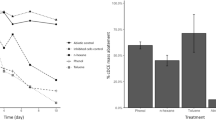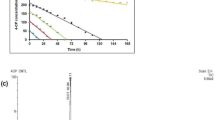Abstract
Chlorophenols are widely used as biocides, leading them to being prevalent environmental contaminants that pose toxic threats to ecosystems. In this study, a Dehalobacter species strain TCP1 was isolated from a digester sludge sample, which is able to dechlorinate 2,4,6-trichlorophenol (2,4,6-TCP) to 4-monochlorophenol (4-MCP) with H2 as the sole electron donor and acetate as the carbon source. Strain TCP1 also distinguishes itself from other Dehalobacter species with its capability to dechlorinate tetrachloroethene or trichloroethene (TCE) to both cis- and trans-dichloroethenes in a ratio of 5.6 (±0.2):1. The growth yields of strain TCP1 on TCE and 2,4,6-TCP were 4.14 × 1013 and 5.77 × 1013 cells mol−1 of Cl− released, respectively. Strain TCP1 contains five unusually long 16S rRNA gene copies per genome, and the extra length is due to the ~110 bp insertion sequences at their 5′-ends. This suggests that strain TCP1 may represent a novel Dehalobacter species. A putative chlorophenol reductive dehalogenase gene—debcprA—was identified to catalyze the ortho-chlorine removal from 2,4,6-TCP. Both the culture-dependent and housekeeping rpoB gene-based approaches indicate the purity of the culture. Strain TCP1 can serve as a promising candidate for the bioremediation of 2,4,6-TCP contaminated sites, and its discovery expands our understanding of metabolic capabilities of Dehalobacter species.




Similar content being viewed by others
References
Adrian L, Hansen SK, Fung JM, Görisch H, Zinder SH (2007) Growth of Dehalococcoides strains with chlorophenols as electron acceptors. Environ Sci Technol 41:2318–2323
Agency for Toxic Substances and Disease Registry (ATSDR) (1990) Toxicological profile for 2,4,6-trichlorophenol. U.S. Public Health Service, U.S. Department of Health and Human Services, Atlanta, GA
Bouchard B, Beaudet R, Villemur R, McSween G, Lepine F, Bisaillon JG (1996) Isolation and characterization of Desulfitobacterium frappieri, sp. nov., an anaerobic bacterium which reductively dechlorinates pentachlorophenol to 3-chlorophenol. Int J Syst Bacteriol 46:1010–1015
Case RJ, Boucher Y, Dahllöf I, Holmström C, Doolittle WF, Kjelleberg S (2007) Use of 16S rRNA and rpoB genes as molecular markers for microbial ecology studies. Appl Environ Microbiol 73:278–288
Cheng D, He J (2009) Isolation and characterization of “Dehalococcoides” sp. strain MB, which dechlorinates tetrachloroethene to trans-1,2-dichloroethene. Appl Environ Microbiol 75:5910–5918
Chow WL, Cheng D, Wang S, He J (2010) Identification and transcriptional analysis of trans-DCE-producing reductive dehalogenases in Dehalococcoides species. ISME J 4:1020–1030
Dahllöf I, Baillie H, Kjelleberg S (2000) rpoB-based microbial community analysis avoids limitations inherent in 16S rRNA gene intraspecies heterogeneity. Appl Environ Microbiol 66:3376–3380
Ding C, He J (2012) Molecular techniques in the biotechnological fight against halogenated compounds in anoxic environments. Microb Biotechnol 5:347–367
Griffin BM, Tiedje JM, Löffler FE (2004) Anaerobic microbial reductive dechlorination of tetrachloroethene to predominately trans-1,2-dichloroethene. Environ Sci Technol 38:4300–4303
Grostern A, Edwards EA (2006a) Growth of Dehalobacter and Dehalococcoides spp. during degradation of chlorinated ethanes. Appl Environ Microbiol 72:428–436
Grostern A, Edwards EA (2006b) 1,1,1-Trichloroethane-degrading anaerobic mixed microbial culture enhances biotransformation of mixtures of chlorinated ethenes and ethanes. Appl Environ Microbiol 72:7849–7856
Grostern A, Edwards EA (2009) Characterization of a Dehalobacter coculture that dechlorinates 1,2-dichloroethane to ethene and identification of the putative reductive dehalogenase gene. Appl Environ Microbiol 75:2684–2693
Grostern A, Duhamel M, Dworatzek S, Edwards EA (2010) Chloroform respiration to dichloromethane by a Dehalobacter population. Environ Microbiol 12:1053–1060
Häggblom M (1990) Mechanisms of bacterial degradation and transformation of chlorinated monoaromatic compounds. J Basic Microbiol 30:115–141
He J, Holmes VF, Lee PKH, Alvarez-Cohen L (2007) Influence of vitamin B12 and cocultures on the growth of Dehalococcoides isolates in defined medium. Appl Environ Microbiol 73:2847–2853
Holliger C, Hahn D, Harmsen H, Ludwig W, Schumacher W, Tindall B, Vazquez F, Weiss N, Zehnder AJ (1998) Dehalobacter restrictus gen. nov. and sp. nov., a strictly anaerobic bacterium that reductively dechlorinates tetra- and trichloroethene in an anaerobic respiration. Arch Microbiol 169:313–321
Holmes VF, He J, Lee PKH, Alvarez-Cohen L (2006) Discrimination of multiple Dehalococcoides strains in a trichloroethene enrichment by quantification of their reductive dehalogenase genes. Appl Environ Microbiol 72:5877–5883
Hölscher T, Krajmalnik-Brown R, Ritalahti KM, von Wintzingerode F, Görisch H, Löffler FE, Adrian L (2004) Multiple nonidentical reductive-dehalogenase-homologous genes are common in Dehalococcoides. Appl Environ Microbiol 70:5290–5297
Kittelmann S, Friedrich MW (2008) Novel uncultured Chloroflexi dechlorinate perchloroethene to trans-dichloroethene in tidal flat sediments. Environ Microbiol 10:1557–1570
Krajmalnik-Brown R, Hölscher T, Thomson IN, Saunders FM, Ritalahti KM, Löffler FE (2004) Genetic identification of a putative vinyl chloride reductase in Dehalococcoides sp. strain BAV1. Appl Environ Microbiol 70:6347–6351
Lee LK, He J (2010) Reductive debromination of polybrominated diphenyl ethers by anaerobic bacteria from soils and sediments. Appl Environ Microbiol 76:794–802
Miller GS, Milliken CE, Sowers KR, May HD (2005) Reductive dechlorination of tetrachloroethene to trans-dichloroethene and cis-dichloroethene by PCB-dechlorinating bacterium DF-1. Environ Sci Technol 39:2631–2635
Muyzer G, De Waal EC, Uitterlinden AG (1993) Profiling of complex microbial populations by denaturing gradient gel electrophoresis analysis of polymerase chain reaction-amplified genes coding for 16S rRNA. Appl Environ Microbiol 59:695–700
Nelson JL, Fung JM, Cadillo-Quiroz H, Cheng X, Zinder SH (2011) A role for Dehalobacter spp. in the reductive dehalogenation of dichlorobenzenes and monochlorobenzene. Environ Sci Technol 45:6806–6813
Ovreas L, Forney L, Daae FL, Torsvik V (1997) Distribution of bacterioplankton in meromictic Lake Saelenvannet, as determined by denaturing gradient gel electrophoresis of PCR-amplified gene fragments coding for 16S rRNA. Appl Environ Microbiol 63:3367–3373
Paster BJ, Falkler WA Jr, Enwonwu CO, Idigbe EO, Savage KO, Levanos VA, Tamer MA, Ericson RL, Lau CN, Dewhirst FE (2002) Prevalent bacterial species and novel phylotypes in advanced Noma Lesions. J Clin Microbiol 40:2187–2191
Pei AY, Oberdorf WE, Nossa CW, Agarwal A, Chokshi P, Gerz EA, Jin Z, Lee P, Yang L, Poles M, Brown SM, Sotero S, Desantis T, Brodie E, Nelson K, Pei Z (2010) Diversity of 16S rRNA genes within individual prokaryotic genomes. Appl Environ Microbiol 76:3886–3897
Regeard C, Maillard J, Holliger C (2004) Development of degenerate and specific PCR primers for the detection and isolation of known and putative chloroethene reductive dehalogenase genes. J Microbiol Methods 56:107–118
Reysenbach AL, Wickham GS, Pace NR (1994) Phylogenetic analysis of the hyperthermophilic pink filament community in Octopus Spring, Yellowstone National Park. Appl Environ Microbiol 60:2113–2119
Robrock K, Korytár P, Alvarez-Cohen L (2008) Pathways for the anaerobic microbial debromination of polybrominated diphenyl ethers. Environ Sci Technol 42:2845–2852
Rupakula A, Kruse T, Boeren S, Holliger C, Smidt H, Maillard J (2013) The restricted metabolism of the obligate organohalide respiring bacterium Dehalobacter restrictus: lessons from tiered functional genomics. Philos Trans R Soc Lond B Biol Sci 368:20120325
Sun B, Griffin BM, Ayala-del-Río HL, Hashsham SA, Tiedje JM (2002) Microbial dehalorespiration with 1,1,1-trichloroethane. Science 298:1023–1025
Tamura K, Dudley J, Nei M, Kumar S (2007) MEGA4: molecular evolutionary genetics analysis (MEGA) software version 4.0. Mol Biol Evol 24:1596–1599
Tang S, Gong Y, Edwards EA (2012) Semi-automatic in silico gap closure enabled de novo assembly of two Dehalobacter genomes from metagenomic data. PLoS ONE 7:e52038
U.S. EPA (1984) Health effects assessment for 2,4,6-trichlorophenol. U.S. Environmental Protection Agency, Washington, D.C., EPA/540/1-86/047 (NTIS PB86134582)
van Doesburg W, van Eekert MH, Middeldorp PJ, Balk M, Schraa G, Stams AJ (2005) Reductive dechlorination of beta-hexachlorocyclohexane (beta-HCH) by a Dehalobacter species in coculture with a Sedimentibacter sp. FEMS Microbiol Ecol 54:87–95
Villemur R, Lanthier M, Beaudet R, Lépine F (2006) The Desulfitobacterium genus. FEMS Microbiol Rev 30:706–733
von Wintzingerode F, Selent B, Hegemann W, Gobel UB (1999) Phylogenetic analysis of an anaerobic, trichlorobenzene-transforming microbial consortium. Appl Environ Microbiol 65:283–286
Wang S, He J (2011) Separation of fluorescence-labelled terminal restriction fragment DNA on a two-dimensional gel (T-RFs-2D)—an efficient approach for microbial consortium characterization. Environ Microbiol 13:2565–2575
Wang S, He J (2013) Phylogenetically distinct bacteria involve extensive dechlorination of Aroclor 1260 in sediment-free cultures. PLoS ONE 8:e59178
Wild A, Hermann R, Leisinger T (1997) Isolation of an anaerobic bacterium which reductively dechlorinates tetrachloroethene and trichloroethene. Biodegradation 7:507–511
Wolin EA, Wolin MJ, Wolfe RS (1963) Formation of methane by bacterial extracts. J Biol Chem 238:2882–2886
Yoshida N, Ye L, Baba D, Katayama A (2009) A novel Dehalobacter species is involved in extensive 4,5,6,7-tetrachlorophthalide dechlorination. Appl Environ Microbiol 75:2400–2405
Acknowledgments
This study was supported by Singapore Agency for Science, Technology and Research (A*STAR) of the Science and Engineering Research Council under Project No: 102 101 0025.
Author information
Authors and Affiliations
Corresponding author
Electronic supplementary material
Below is the link to the electronic supplementary material.
Rights and permissions
About this article
Cite this article
Wang, S., Zhang, W., Yang, KL. et al. Isolation and characterization of a novel Dehalobacter species strain TCP1 that reductively dechlorinates 2,4,6-trichlorophenol. Biodegradation 25, 313–323 (2014). https://doi.org/10.1007/s10532-013-9662-1
Received:
Accepted:
Published:
Issue Date:
DOI: https://doi.org/10.1007/s10532-013-9662-1




